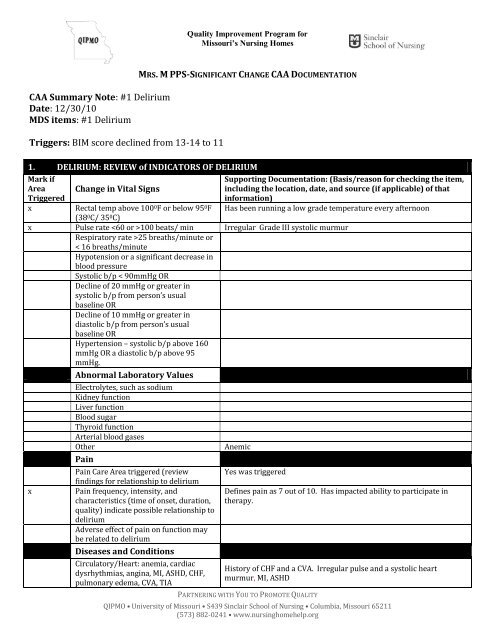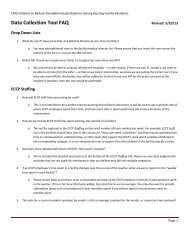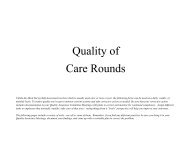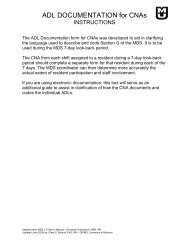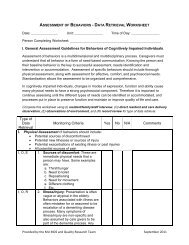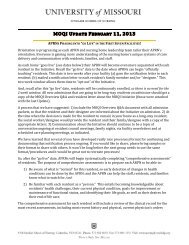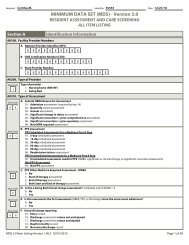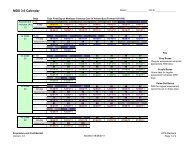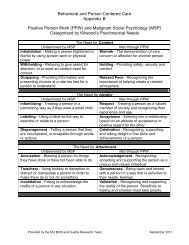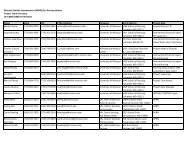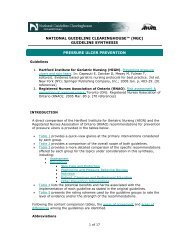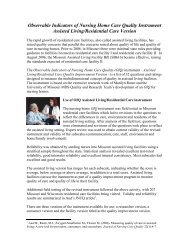CAA Documentation - Nursing Home Help
CAA Documentation - Nursing Home Help
CAA Documentation - Nursing Home Help
You also want an ePaper? Increase the reach of your titles
YUMPU automatically turns print PDFs into web optimized ePapers that Google loves.
Quality Improvement Program forMissouri’s <strong>Nursing</strong> <strong>Home</strong>s<strong>CAA</strong> Summary Note: #1 DeliriumDate: 12/30/10MDS items: #1 DeliriumTriggers: BIM score declined from 13-14 to 11MRS. M PPS-SIGNIFICANT CHANGE <strong>CAA</strong> DOCUMENTATION1. DELIRIUM: REVIEW of INDICATORS OF DELIRIUMMark ifAreaTriggeredxChange in Vital SignsSupporting <strong>Documentation</strong>: (Basis/reason for checking the item,including the location, date, and source (if applicable) of thatinformation)Has been running a low grade temperature every afternoonRectal temp above 100 0 F or below 95 0 F(38 0 C/ 35 0 C)x Pulse rate 100 beats/ min Irregular Grade III systolic murmurRespiratory rate >25 breaths/minute or< 16 breaths/minuteHypotension or a significant decrease inblood pressureSystolic b/p < 90mmHg ORDecline of 20 mmHg or greater insystolic b/p from person’s usualbaseline ORDecline of 10 mmHg or greater indiastolic b/p from person’s usualbaseline ORHypertension – systolic b/p above 160mmHg OR a diastolic b/p above 95mmHg.xAbnormal Laboratory ValuesElectrolytes, such as sodiumKidney functionLiver functionBlood sugarThyroid functionArterial blood gasesOtherPainPain Care Area triggered (reviewfindings for relationship to deliriumPain frequency, intensity, andcharacteristics (time of onset, duration,quality) indicate possible relationship todeliriumAdverse effect of pain on function maybe related to deliriumDiseases and ConditionsCirculatory/Heart: anemia, cardiacdysrhythmias, angina, MI, ASHD, CHF,pulmonary edema, CVA, TIAAnemicYes was triggeredDefines pain as 7 out of 10. Has impacted ability to participate intherapy.History of CHF and a CVA. Irregular pulse and a systolic heartmurmur, MI, ASHDPARTNERING WITH YOU TO PROMOTE QUALITYQIPMO • University of Missouri • S439 Sinclair School of <strong>Nursing</strong> • Columbia, Missouri 65211(573) 882-0241 • www.nursinghomehelp.org
Respiratory: asthma, emphysema, COPD,shortness of breath,Infectious: Infections, wound infectionother than foot or lower extremity,Isolation - activeMetabolic: diabetes, thyroid,hyponatremiaGastrointestinal bleedRenal disease, dialysisHospice CareCancerDehydrationSigns of Infection (fromobservation, clinical recordFeverCloudy or foul smelling urineCongested lungs or coughDyspneaDiarrheaAbdominal painPurulent wound drainageErythema around an incisionIndicators of DehydrationDehydration care area triggered,indicating s/s of dehydration arepresentRecent decrease in urine volume ormore concentrated urine than usualRecent decrease in eating habits –skipping meals or leaving food uneaten,weight lossNausea, vomiting, diarrhea or blood lossReceiving IV medsReceiving diuretics or drugs that maycause electrolyte imbalanceFunctional StatusRecent decline in ADL statusIncreased risk for fallsMedications (that may contribute todelirium)New med or dosage increaseDrugs w/anticholinergic properties(antipsychotics, antidepressants,antiparkinsonian, antihistamines)OpioidsBenzodiazepines, especially long actingAnalgesics, cardiac and GI meds, antiinflammatorydrugsRecent abrupt discontinuation,omission, or decrease in dose of ashort/long acting benzodiazepineDrug interactionsResident taking more than one drugfrom a particular class of drugsPossible drug toxicity, esp. if the personSOB if lies flatRecent hospital stay with foley catheter that has now been removedOn thyroid replacementDX GI Bleed and UlcerDaily afternoon elevated temperaturesSOB if lies flatNo S/S but did have IV fluids in hospital for hydration after surgeryDecrease appetite with recent weight lossHistory of GI Bleed. Recent blood transfusion post surgery.Bumex dailyRequires more assist since hip fxFell causing fx hipProzac was just increased but symptoms were noted before increaseOn both cardiac, GI meds, and analgesicsMU MDS and Quality Research Team, Sinclair School of <strong>Nursing</strong>, University of Missouri (revised 03/11) 2
is dehydrated or has renal insufficiency.Check serum drug levelsAssociated or Progressive Signsand SymptomsSleep disturbances (up & awake at noc,asleep during day)Agitation & inappropriate movements(unsafe climbing out of bed or chair,pulling out tubes)Hypoactivity (low or lack of motoractivity, lethargy or sluggish responses)Perceptual disturbances such ashallucinations and delusionsOther ConsiderationsPsychosocial:- Recent change in mood: sad oranxious, crying, social withdrawal- Recent change in social situation(isolation, recent loss of family orfriendPhysical or environmental factors:- Hearing or vision impairment, mayhave an impact on ability to processinformation like directions,reminders, environmental clues- Lack of frequent reorientation,reassurance, reminders to help makesense of things- Recent change in environment (roomchange, new admission, return fromhosp)- Interference w/resident’s ability toget enough sleep (light, noise,frequent disruptions)- Noisy or chaotic environment (callingout, loud music, constant commotion,frequent caregiver changes)Input from resident and/or family orrepresentative regarding the care area.Questions/comments/concernsPreferences/suggestionsAnalysis of FindingsReview indicators and supporting documentation,and draw conclusions.Document: Description of the problem Causes and contributing factors Risk factors related to the care areaProblem: Mrs. M’s BIM score has decreased fromprevious assessment.Causes: Low grade fever, multiple medical diagnosesincluding CHF, CVA, hypothyroid, and anemia.Recent hospitalization with surgery.Risk factors: Increase confusion may interfere withAltered levels of consciousnessSluggishFell less than a week ago resulting in a hip fracture which resulted inthe hospital stay. Returning now as more depressedDX Depression. Prozac recently increased.Return from hospital. Is having difficulty processing new informationat this time.Dx macular degeneration, Hard of HearingFamily has noted a decline since returning from hospitalCarePlan?YesNoYesCare Plan ConsiderationsDocument reason(s) care plan will or will not bedeveloped.Care plan to be developed to monitor currentlevel of cognition for further decline. Willincorporate interventions to minimize furtherloss of cognitionMU MDS and Quality Research Team, Sinclair School of <strong>Nursing</strong>, University of Missouri (revised 03/11) 3
providing care, and put Mrs. M at risk for furtherinjury such as another fall, skin breakdown, weightloss, etc.Referral to another discipline is warranted - to whomand why?Speech to see for compensatory techniques<strong>CAA</strong> Summary Note: #2 Cognitive Loss/DementiaDate: 12/30/10MDS items: BIM score less than 13 C0500 and inattention and altered level of consciousness C01300Analysis: Mrs. M does show signs of delirium, see Delirium <strong>CAA</strong> 12/30/10. She does have a history of aCVA with new onset of changes in behavior in inattention and altered levels of consciousness. Her PHQ-9also shows an increase in depression from her previous assessment. Medically she does have a thyroiddisorder, ASHD, Hx of MI and GI Bleed/Ulcer, CHF, SOB with activity and inability to lie flat, anddepression. Pain control has also been an issue since readmission but better participation noted intherapy over the last several days. Due to her recent surgery she does require more assistance with herADL’s. In the last week she has also had several environmental changes between the hospital and thenursing home which may also impact her cognition. Speech therapy to see. Will care plan to minimizefurther decline and to possibly improve her cognitive ability with continuity of care and painmanagement.Decision to proceed with care plan - YES<strong>CAA</strong> Summary Note: #3 Visual Function; #4 CommunicationDate: 12/30/10MDS items: Vision Impaired: B1000 Hearing, B0200 and Ability to understand others: B0800Mrs. M triggered for these <strong>CAA</strong> areas due to sensory deficits, resulting in highly impaired vision andhearing. There have been no changes in either area since the original admission. See Visual Function andCommunication <strong>CAA</strong> note dated 1/21/10.Decision to proceed with care plan - YES<strong>CAA</strong> Summary Note: #5 ADLs; #11 FallsDate: 12/30/10MDS items: #5 ADL’s - Requires assistance with ADLs G0110 and has a decline in cognition C0500; #11Falls - Has balance problems G0300See PT eval 12/21/10 and OT eval 12/21/10Vision/Communication <strong>CAA</strong> 12/30/10 and Urinary incontinence <strong>CAA</strong> dated 12/30/10Mrs. M triggered for the above <strong>CAA</strong>s due to her need for limited to extensive assistance with ADLs and arecent fall resulting in a fracture. PT and OT have addressed recommendations for Mrs. M’s ADL status.In addition to a recent history of falls, Mrs. M is at fall risk due to possible medication side effects, urinaryincontinence; weakness requiring limited to extensive staff assist at times because of fatigue, and sensoryMU MDS and Quality Research Team, Sinclair School of <strong>Nursing</strong>, University of Missouri (revised 03/11) 4
deficits. Medications that contribute to fall risk include Prozac, Bumex, Calan, NTG (PRN) and Digoxin.Pharmacy review to be done per facility protocols to determine further recommendations at this time.Urinary incontinence is related to urgency secondary to diuretics and is likely to be exacerbated byrecent catheter insertion.Decision to proceed with care plan - YES, to alert staff to multiple risks for falls, and assistance with ADL’s<strong>CAA</strong> Summary Note: #6 Urinary IncontinenceDate: 12/30/10MDS items: Incontinence and requires assistance with toileting H0300Mrs. M triggered for this <strong>CAA</strong> due to urinary incontinence that has been a problem for her since prior toher admission at home and has continued since her original admission. A bladder diary was done withthe first admission and has been repeated during days 3-6 of this stay (See <strong>Nursing</strong> Note 12/26/10).During the hospitalization a catheter had been inserted but has since been removed on 12/21/10. Sincethe removal Mrs. M has been incontinent several times a week, which is similar to her voiding patternprior to hospitalization. This was confirmed by comparing the current dairy with the previous admissiondiary. Mrs. M is unable to ambulate to the BR w/ walker due to fatigue. She requires weight bearingassistance of one person to transfer on/off the commode. She is able to call for assistance, but due tourgency can only hold her urine for about 5 minutes. Urgency is greater in the morning after Bumexadministration. Delirium was also a possible incontinence factor as well as her increased need forassistance in toileting.Decision to proceed with care plan – YES<strong>CAA</strong> Summary Note: #10 ActivitiesDate: 12/30/10MDS Items: Little interest or pleasure in doing thingsD0200 AMrs. M triggered for Activities due to the observation of little interest or pleasure in doing things. She hasbeen a resident her for over a year. Prior to this most recent hospitalization she was an active participantin activities inside the home and occasionally went out with her daughter. She enjoyed small groupactivities but also enjoyed her time working on crossword puzzles. Currently due to pain, therapyattendance she has been too tired to participate in many activities. There are no other barriers such asenvironmental or staffing at this time. Review also the Cognitive loss, Delirium and Mood state <strong>CAA</strong>s12/30/10.Decision to proceed with care plan – YES<strong>CAA</strong> Summary Note: #12 Nutritional Status; #14 Dehydration/Fluid MaintenanceDate: 12/30/10MDS items: #12 Nutritional Status - Therapeutic diet K0500; #14 Dehydration/Fluid Maintenance -Taking diuretic: N0400See current dietary note dated 12/22/10. No change essentially since original admission; see <strong>CAA</strong> notedated 1/19/10 for Nutritional Status and Dehydration/Fluid MaintenanceMU MDS and Quality Research Team, Sinclair School of <strong>Nursing</strong>, University of Missouri (revised 03/11) 5
Decision to proceed with care plan - YES<strong>CAA</strong> Summary Note: #8 Mood state; #17 Psychotropic DrugsDate: 12/30/10MDS items: #8 Mood state - Would be better off dead D0200 and increase in PHQ 9 from last assessmentto current assessment D0300; #17 Psychotropic Drugs - Antidepressant N0400Mrs. M was readmitted back to the facility after a fall resulting in hip fracture requiring surgery and a 3day hospitalization. Mrs. M has a history of depression secondary to CVA and has taken Prozac since1997. Upon readmission she showed signs of delirium, decline in ADL’s with diagnosis of cardiacdisease, and post CVA. She is on cardiac and pain medications. She is on thyroid replacement. Willcontact Dr. G for a thyroid level as no levels have been drawn in over a year. Dr. G is aware of her wish todie but denied that she had a plan to follow through with those thoughts. She has been on Prozac but ithas recently been increased..Decision to proceed with care plan - YES<strong>CAA</strong> Summary Note: #16 Pressure Ulcers M0300Date: 12/30/10MDS items: Currently has 2 pressure ulcersMrs. M. triggered for pressure ulcers due to an intact blister on her left heel that developed during herhospital stay as well as a nonblanchable area on her coccyx. Risk factors include: decreased mobility,friction and shear from sliding in bed, stress incontinence, delirium. She is on an antidepressant but thisis a long standing medication and it has been increased recently. She has diagnosis of delirium, post CVA,depression, and edema. She also has the following conditions: recent weight loss, SOB if lies flat, and arecent decline in ADL’s. Other factors include recently readmitted, and head of bed elevated for ease inbreathing. Will care plan to ensure pressure is reduced to that area and that no further problems develop.Decision to proceed with care plan - YES<strong>CAA</strong> Summary Note: #19 PainDate: 12/30/10MDS Items: Pain has limited day to day activities J0500Diseases: Circulatory, pressure ulcers, post stroke, hip fractureCharacteristics of pain: Left hip, intermittent with an increase with movement, and decrease with rest.Pain described as throbbingFrequency: Hurts worst with ambulation and lessens after sittingPain effect on function: Does not disturb sleep, but appetite has decreased; more depressed compared toprevious admission and impacts ability to complete ADL’sAssociated signs and symptoms: deliriumOther considerations: Decrease in mobility due to recent surgeryMU MDS and Quality Research Team, Sinclair School of <strong>Nursing</strong>, University of Missouri (revised 03/11) 6
Decision to proceed with care plan - YESMU MDS and Quality Research Team, Sinclair School of <strong>Nursing</strong>, University of Missouri (revised 03/11) 7


